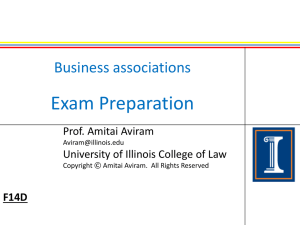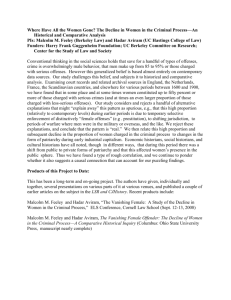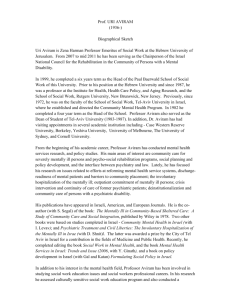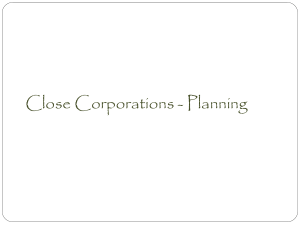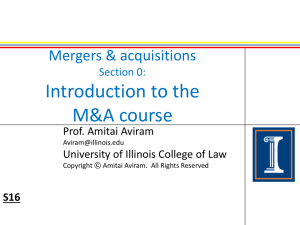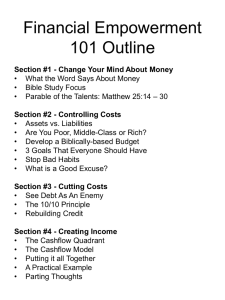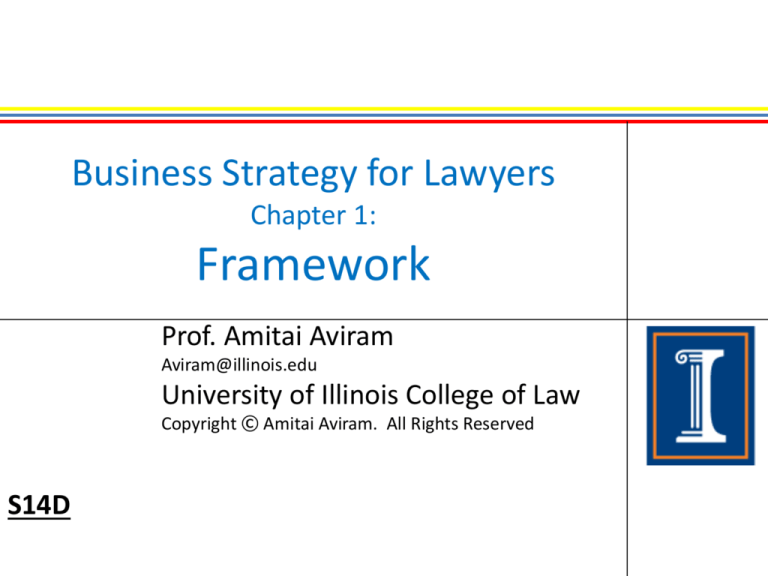
Business Strategy for Lawyers
Chapter 1:
Framework
Prof. Amitai Aviram
Aviram@illinois.edu
University of Illinois College of Law
Copyright © Amitai Aviram. All Rights Reserved
S14D
Framework
Overview of Chapter 1
a)
b)
c)
d)
2
Introduction to BSL
What is business strategy?
Business intelligence
The value pool
© Amitai Aviram. All rights reserved.
Introduction to BSL
What this course is/isn’t about
• No law (!!!)
– Course is about how firms behave to maximize their profits
• Some such behavior can violate the law (e.g., antitrust)
– Course will give you a deeper understanding
of how businesspeople think
• Your clients
• You (if you’re a partner/solo practitioner)
• The businesses you oversee (if you’re a regulator)
• But not a business school course either…
– Business strategy for lawyers
– This course does not prepare you to be CEOs
– It prepares you to either be:
• Regulators; or
• Lawyers representing corporate clients before regulators
3
© Amitai Aviram. All rights reserved.
Introduction to BSL
What this course is/isn’t about
• What does that mean?
– Consider both individual firm & market-wide impact
• CEO focuses only on own firm, subject to legal constraints
• Regulator interprets/enforces law, so “subject to legal constraints” would
lead to circular thinking
– Emphasis on present analysis, not future predictions
• CEO sets firm’s course
• Regulator makes decisions based on existing market conditions (& defend
in court if challenged, so solid evidence is required)
4
© Amitai Aviram. All rights reserved.
Introduction to BSL
What this course is/isn’t about
• This is not a course about picking good stocks
– Fundamental analysis of investments does require knowledge of
business strategy, but it also requires assessing what is the firm’s
value
– But the analysis we use can help strategize your career
• So what is the course about? (i.e. what is strategy?)
– Creating/maintaining a fit between the strategic environment & firm’s
strategic traits (applying strengths to opportunities), in order to best
achieve the firm’s goals
– More about this in the “What is strategy?” section (BSL 1c)
5
© Amitai Aviram. All rights reserved.
Introduction to BSL
The challenges of studying BSL
• Dealing with uncertainty
– Law classes tend to assume a lot of certainty about the analytic process (e.g., a
given test determines if X is liable)
– But real life (including legal practice) is not nearly as certain – e.g., no rules &
no analytical process that ensures business success
– A good analytical process helps focus on the issues that are likely to be the
more relevant to success & identify tradeoffs between those issues
• Collecting information (business intelligence)
– Law classes tend to provide you with the relevant information
– But in real life, unless you have the power to subpoena information, you need
to think of creative proxies for the information you actually need
– In this course, creative ways to collect information are a big part of the grading
of your market analysis & team activities
6
© Amitai Aviram. All rights reserved.
Introduction to BSL
Grading
• Market analysis report
– Expected length: 10 pages or more
– You pick the market you analyze
• Students often pick either a market they are customers of, had worked in,
or plan to work in (e.g., bankruptcy practice in northwest Illinois)
• Grade adjustments
– For:
• Attendance & participation in class discussion
• Participation in & quality of team activities
– Up to 1 grade-point up, unlimited adjustment down
• However, an upwards or downwards adjustment of more than ⅓ of a grade
point (e.g., from B+ to A-) is rare
7
© Amitai Aviram. All rights reserved.
Introduction to BSL
Market analysis report
• Select your market ASAP, so you can think of each new class through
the lens of your market
– And figure out what information you’ll need to get
– Key criteria: experience, interest & availability of information
• Quality criteria
– Analysis (thoughtful application of analytical tools studied in this course)
– Business intelligence (creative ways of collecting information)
• All sources of info must be clearly referenced
• Doesn’t qualify for ULWR credit
• Due on April 26 (Friday of the last full week of classes)
– Submit the paper by e-mail, as MS-Word (.doc or .docx) file
– Last class of the course (Monday, April 29) is cancelled; make-up will be
announced
8
© Amitai Aviram. All rights reserved.
Introduction to BSL
Getting more information
• Slides, course outline & syllabus are posted and
regularly updated on my website
– http://www.law.illinois.edu/aviram/
• Talking to me outside of class
– Please e-mail prior to meeting with me
• Suggest when you would like to meet
(not limited to office hours)
• Describe what you want to talk about
– E-mail: aviram@illinois.edu
– Room 326
9
© Amitai Aviram. All rights reserved.
Introduction to BSL
Defining commonly-used terms
•
•
•
Product: a good or a service
Market: set of products that are close substitutes for each other
Firm: a business that is involved in creating, modifying or
distributing products (regardless of its legal status)
Rivals (of a given firm): Other firms that participate in the same
market(s) – i.e., other firms that sell products that are close
substitutes to products of the given firm
Producers (re a given firm): firm + its rivals
Supplier (of a given firm): person selling raw materials to firm
Customer (of a given firm): person buying product from firm
•
•
•
•
–
–
10
Customer may consume product or use it as raw material in its business
Consumer: a customer who buys a product for personal use, rather than as
raw material to produce & sell something
© Amitai Aviram. All rights reserved.
Framework
Overview of Chapter 1
a)
b)
c)
d)
11
Introduction to BSL
What is business strategy?
Business intelligence
The value pool
© Amitai Aviram. All rights reserved.
What is business strategy?
Strategy & goals
• Strategy is a planning process designed to achieve the
firm’s goal(s)
– Since this is a business strategy course, I will assume that the
firm’s goal is to maximize the firm’s sustainable profits
– But similar tools apply to other goals (e.g., for non-profits, states,
individuals)
• That’s the goal of most business functions, not just strategy
– Operations management
– Research & development
– Human resources
• What distinguishes strategy from other business functions?
12
© Amitai Aviram. All rights reserved.
What is business strategy?
What distinguishes strategy?
• Strategy addresses two questions:
– Which markets should the firm participate in to advance its goals?
• I.e., which pies do you want to have slices in?
– How can the firm create a sustainable competitive position in a
market in which it participates?
• I.e., how can your firm get a bigger slice in those pies?
13
© Amitai Aviram. All rights reserved.
What is business strategy?
Which markets?
• Abstract answer to the first question (which markets to
participate in): markets with
– A large or growing value pool (the total amount of value created
by the business activities)
– In a benign strategic environment
• Strategic environment: the set of economic constraints that determines
how much of the value of a business activity is captured by market
participants (firm & rivals) rather than other actors (customers & suppliers)
Value pool
The strategic environment
Substitution
Total value created by biz activity
(from raw materials to finished
product delivered to consumers)
14
Entry
Rivalry
Allocates the value pool between markets
© Amitai Aviram. All rights reserved.
Supply chain
What is business strategy?
How to gain a sustainable competitive position?
• Abstract answer to 2nd question (sustainable competitive position):
creating/maintaining a position that’s valuable, unique & sustainable,
because of a fit between strategic environment & firm’s strategic traits
The strategic environment
(Identifying threats & opportunities)
Firm’s strategic traits
Strategic actions
(firm-specific competences & rigidities)
(Applying firm’s traits to improve the environment for firm)
Position
(Valuable, unique & sustainable match
between environment & traits)
15
© Amitai Aviram. All rights reserved.
What is business strategy?
Competitive position & SWOT analysis
• SWOT analysis (Strengths, Weaknesses, Opportunities, Threats)
is a simple, all-purpose strategic tool
• Concept: match strategic environment
to firm’s strategic traits
– Environment divided between
good (opportunities) & bad (threats)
– Firm’s traits divided between
good (strengths) & bad (weaknesses)
• But SWOT analysis is simplistic
– Makes a sharp good vs. bad distinction, when in reality many factors are
somewhere in the middle
– More detailed tools are available to analyze both environment & firm
• Environment: substitution, entry, rivalry, supply chain
• Firm: strategic competences, strategic rigidities
16
© Amitai Aviram. All rights reserved.
What is business strategy?
Summary: what distinguishes strategy?
Firm’s goals (maximize sustainable profits)
Which markets should the firm participate in to
advance its goals?
Value pool
Strategic environment (substitution, entry, rivalry, supply chain)
Strategic environment (current & future)
How can the firm create a sustainable competitive
position in a market in which it participates?
Strategic traits (firm-specific competences & rigidities)
Strategic actions (differentiation, coordination, confrontation)
• The table above summarizes the questions strategy addresses
and the tools it uses to address those questions
–
–
–
–
17
We study the value pool in Section 1d
Strategic environment: Chapter 2
Strategic traits: Section 3a
Strategic actions: the rest of Chapter 3
© Amitai Aviram. All rights reserved.
Framework
Overview of Chapter 1
a)
b)
c)
d)
18
Introduction to BSL
What is business strategy?
Business intelligence
The value pool
© Amitai Aviram. All rights reserved.
Business intelligence
Developing a research plan
•
–
•
–
–
–
–
–
19
A major element in the quality of your market analysis is your
ability to acquire information for your analysis (the other major
element is the analysis itself)
Doesn’t mean you should pick a market that has a lot of media exposure, or
that’s publicly listed – you can get all the info you need from observation,
interviewing, and other research methods
Process
Background reading of secondary sources (media, analyst reports, public SEC
filings, etc.) to get a “feel” for the industry
Create a report outline (based on the outline we will discuss in Section 3e),
fill in the info you have & note the info you lack
For each item of info you lack, determine what the ideal info would be, then
think of proxies from available sources that can substitute for the ideal info
Analyze the reliability of info you collected (including direction of bias)
Depending on reliability & importance of the info to your analysis, determine if
you need to collect more info on the issue
© Amitai Aviram. All rights reserved.
Business intelligence
Research methods
•
•
–
–
–
–
–
–
–
•
20
–
Secondary research
Data that has already been collected by someone else: public filings that
firms make to the Securities & Exchange Commission or other regulators,
analyst reports, books, newspaper articles and interviews, blogs & websites
Advantage: somebody did the work for you
Disadvantages: info you need may not be available; info may not be reliable
(Primary) quantitative research
Acquire numerical data & analyzing it using statistical/accounting techniques
Acquire the data from secondary sources, via survey, experiment, or quantify
data that is non-numerical (e.g., number of newspaper articles in which word
X appears each year)
Advantage: gives precise results
Disadvantages: requires statistical or accounting knowledge, need high
quality quantitative data, results depend on soundness of model’s
assumptions
(Primary) qualitative research
Methods that analyze data that you collect without quantifying it
© Amitai Aviram. All rights reserved.
Business intelligence
Research methods
•
Qualitative research techniques
–
–
–
–
21
Observation (physical or online)
Interviewing (face-to-face, e-mail, phone, etc.)
Surveys (multiple choice, quantitative, or open-ended): allow getting input
from many people, but requires knowing exactly what you want to ask (no
ability to follow up), and is time-consuming to process open-ended answers
Focus groups (discussion among multiple participants, moderated by the
researcher): useful for brainstorming creative ideas or to discuss products
that the individuals have little experience with, and for products which are
consumed collectively or in which the benefit is connected to interacting
with others
© Amitai Aviram. All rights reserved.
Business intelligence
Team project: business intelligence
•
In the first team project we will gather business intelligence about
one issue that comes up early in a market analysis – identifying the
bases of competition
The first steps in your market analysis reports are:
•
–
Determining your starting point product
•
•
•
•
–
Finding the basis of competition
•
22
You must begin by defining a specific product as your starting point,
because different products (even similar ones) may be impacted
differently by market forces
If you are analyzing a merger/JV: each common product + synergy with
not-common products
If you are analyzing a firm: each of its products
If you are analyzing a market: most typical product in the market
I.e., what makes the product good/better?
© Amitai Aviram. All rights reserved.
Business intelligence
Team project: business intelligence
• To find the bases of competition, start with customer needs that the
product satisfies
– Example: Product – J.D. degree; customer needs: getting a job @ big corporate
law firm; getting promoted in current job; making professional contacts; sense
of accomplishment; intellectual challenge
• For each need, identify customer benchmarks
– What do customers look at to see if product responds to their needs?
– Example: Product – J.D. degree; Customer benchmarks: US news ranking;
perhaps % of grads who have such jobs (but do customers actually get this
data?); geographical location
– Benchmark doesn’t have to correctly reflect need; just be perceived by
potential customers as reflecting their needs
23
© Amitai Aviram. All rights reserved.
Business intelligence
Team project: business intelligence
• Working in a team, please research what are the bases of
competition for a (U.S.) JD or LLM degree
– Starting point product: Illinois JD or LLM degree
– Figure out both customer needs & customer benchmarks
– The methods you use to collect information are as important as
your conclusions
• Write your findings in an e-mail to me
(1 e-mail per team)
24
© Amitai Aviram. All rights reserved.
Framework
Overview of Chapter 1
a)
b)
c)
d)
25
Introduction to BSL
What is business strategy?
Business intelligence
The value pool
© Amitai Aviram. All rights reserved.
Value pool
Defining value
•
Value: benefit to the buyer of a product minus all costs of
getting the product to the buyer
–
–
–
Value vs. profit: a seller’s share of the value it creates is its profit,
but not all value is usually captured by the seller
Value is shared between customers, sellers & firms in other
links of the supply chain
E.g., I value a gadget @$500; I buy it for $250; it costs $100 to
produce
•
–
26
Value: $400; seller’s profit: $150; buyer surplus: $250
Note that value changes from buyer to buyer; profit is constant as
long as costs & price remain the same
© Amitai Aviram. All rights reserved.
Value pool
Defining the value pool
•
Value pool: aggregate value that can be captured by
market participants (firm, rivals or customers)
–
–
•
Size of the value pool determined by:
–
–
•
Value margin (value – cost)
Volume of sales
Expanding the value pool is important to a firm’s
profitability, but is mostly outside this course’s scope
–
27
Firms’ share of the value pool is its profits
Customers’ share of the value pool is the consumer surplus
We will briefly discuss highlights; in the report, address only if
you very knowledgeable about the market
© Amitai Aviram. All rights reserved.
Value margin
Value margin vs. profit margin
•
Profit margin = (price – cost)/price
–
Example: Producing 3 widgets costs $5/widget in variable costs + $3 in
overhead costs. Widgets are sold for $8/each
Total costs = $18 ($6/widget)
–
•
–
•
28
Profit margin = (8-6)/8 = 2/8 = 25%
Value margin = (average value – cost)/average value
–
•
Cost/widget would change if you produced more widgets
E.g., if widgets are valued at $11, $10 & $9, then average value is $10,
and value margin is: (10-6)/10 = 40%
Profit margin can be increased by increasing the value margin, but
it can also be increased by increasing the firm’s share of the existing
value pool (i.e., by reducing competition)
© Amitai Aviram. All rights reserved.
Value margin
Increasing the value margin
•
Adding value
–
–
•
Cutting cost
–
Operations management: exploit economies of scale & scope, improve
efficiency of the production processes
–
Financial management: cashflow synergies, diversification, fin. engineering
•
Value margin is also affected by spillover effects from other markets
in supply chain; e.g.,
–
–
29
Engineering: add features, improve product performance, etc.
Marketing: change customer perceptions of product’s value
Adding value: crude oil was originally refined into kerosene for lighting.
Invention of the car added value (and volume) to crude oil, because it
could be refined into gasoline
Cutting cost: technological changes in mining that lower cost of iron
ore can increase value margin for producing steel
© Amitai Aviram. All rights reserved.
Value margin
Cashflow synergies
•
Fast-growing businesses require large investments
–
–
–
•
Other markets have low growth prospects, but generate a
stable stream of income
–
•
E.g., many cable operators, newspapers, utility companies
Financial costs can be reduced by matching activity in
cash-using markets & cash-generating markets
–
30
Firm must first invest/take losses and only later recoup profits, so
these businesses result in a negative cashflow
E.g., eBooks, smart phones, internet search engines
Why invest in a business with negative cashflow?
Why does this reduce financial costs? Can’t the firm borrow cash
or issue shares to raise cash rather than generate it?
© Amitai Aviram. All rights reserved.
Value margin
Cashflow synergies: BCG matrix
•
The BCG (Growth-Share) matrix is one tool
designed to manage market portfolios in way that evens
out the cashflow
–
–
31
Uses market growth as
proxy for cash usage
Uses market share as proxy
for cash generation
© Amitai Aviram. All rights reserved.
Value margin
Cashflow synergies: cash cow
•
Cash cow: Mature market generating significant positive
cashflow
–
–
32
Fund the firm’s other activities
Why not have only cash cows?
© Amitai Aviram. All rights reserved.
Value margin
Cashflow synergies: star
•
Star: Promising market, firm is well positioned in it;
currently has negative cashflow
–
33
The future of the firm;
funded by firm’s cash cows
(or by external financing)
© Amitai Aviram. All rights reserved.
Value margin
Cashflow synergies: question mark
•
Question mark: Promising market, but firm is
poorly positioned; currently has negative cashflow
–
Firm must decide: Either •
•
34
Invest heavily in order to
capture dominant position
(turn into a star); or
Get out of the market
© Amitai Aviram. All rights reserved.
Value margin
Cashflow synergies: dog
•
Dog: Mature market & firm is poorly positioned; cashflow
(positive or negative) is not significant
–
35
Get out of the market (sell or shut down)
© Amitai Aviram. All rights reserved.
Value margin
Cashflow: changes over time
•
A product shifts positions over its lifecycle
Firm maintains lead
Success
Market
Matures
Firm
invests
Firm loses lead
Failure
36
© Amitai Aviram. All rights reserved.
Firm loses lead
or market declines
Value margin
Diversification
•
Diversification attempts to reduce the volatility of profits
(bad years less bad; good years less good)
•
How is this different from cashflow considerations?
–
–
37
Cashflow: match markets that need cash with markets that
produce cash; use present profits to create future profits
Diversification: match markets that do well in certain
circumstances with markets that do well in opposite
circumstances; use present profits to offset present losses
© Amitai Aviram. All rights reserved.
Value margin
Diversification: some terminology
• The outcome of most investments is uncertain
• To evaluate investments, we estimate probabilities of outcomes
– E.g., 50% likelihood of a 6% return; 50% likelihood of -4% return
– If the estimate is correct, we no longer have uncertainty, but we still
have risk
– What has risk but no uncertainty?
• Investments are evaluated on two dimensions:
– Return: The average expected profit from the investment
• In the example above: 1%
– Risk: The likely deviation from the average
• In the example above: ±5%
38
© Amitai Aviram. All rights reserved.
Value margin
Diversification: understanding risk
• Consider 3 investments, all of which offer 10% return
– A – U.S. Treasury Bond: 100% probability of a 10% return
– B – Mature market
• 50%: earn a 0% return
• 50%: earn a 20% return
– C – Emerging market
• 50%: -100% return (lose entire investment)
• 50%: 120% return
• Risk of each investment:
– A: No deviation from average – Zero risk
– B: ±10% deviation from average
– C: ±110% deviation from average – 11 times the risk of B
39
© Amitai Aviram. All rights reserved.
Value margin
Diversification: understanding risk
• Review:
– Investment A
• 50% chance: 1% return
• 50% chance: 3% return
Average: 2%
Deviation from Avg. ± 1%
– Investment B
• 50% chance: 3% return
• 50% chance: 13% return
Average: 8%
Deviation from Avg. ± 5%
• Which is the riskier investment?
• Then why do we want to avoid higher risk?
40
© Amitai Aviram. All rights reserved.
Value margin
Diversification: how does it work?
• Diversification reduces risk without reducing the return
– Reason: Regression to the mean
– Imagine you are flipping a coin 10 times, counting how often it
falls on heads
– Now imagine you are flipping the coin 1,000 times
– What’s more likely:
• Coin fell on heads between 4 & 6 times out of 10
• Coin fell on heads 400-600 times out of 1,000
41
© Amitai Aviram. All rights reserved.
Value margin
Diversification: how does it work?
• Jane owns 10 shares of Acme. Having just heard that she
needs to diversify, she buys another 990 Acme shares. Did
she reduce her risk?
42
© Amitai Aviram. All rights reserved.
Value margin
Diversification: correlation
• Additional “bets” diversify only to the extent that they are
not correlated with the existing bets
– Correlation: The observation that when there’s a change
in A, there’s a change in B
43
© Amitai Aviram. All rights reserved.
Value margin
Diversification: full correlation
• Two Acme shares: whenever there’s a change
in the price of one share, there’s an identical change in the
other share – correlation between the shares is 1 (fully
correlated)
– Splitting your funds between these two investments
does not diversify at all
• Acme share & Ajax share: Ajax owns 30% of
Acme’s shares, owns no other assets & has no other
business – correlation is 1
– Again, splitting funds between these two investments offers no
diversification
44
© Amitai Aviram. All rights reserved.
Value margin
Diversification: some/no correlation
• Microsoft share & a lottery ticket: MS’s share price doesn’t
affect chance of winning lottery or vice versa, so correlation is 0
(not correlated)
– Splitting your funds between these two investments diversifies
• Bank of America share & Citibank share: Some factors affect
both companies prices (e.g., interest rates); other factors are
independent for each company. Correlation is, say, 0.6
(partially correlated)
– Splitting your funds between these two investments diversifies
somewhat, but not as well as the previous example
45
© Amitai Aviram. All rights reserved.
Value margin
Diversification: negative correlation
• Ford share & ExxonMobil share: Exxon rises &
Ford drops when gas prices are high. Correlation
is, say, -0.3 (negatively correlated)
– Splitting your funds between these two investments is
called “hedging” (partial protection in case your bet is
wrong)
• Buying a Ford share & Shorting a Ford share: Correlation is
-1 (whenever one investment goes up, the other goes
down by the same amount)
– The two investments cancel out each other (if equal
amounts invested in each)
46
© Amitai Aviram. All rights reserved.
Value margin
Diversification: theory to practice
• Firms diversify by operating in several markets that have a low
correlation with each other: firm’s returns should be close to the
projected (i.e., average) returns
• Firms hedge by operating (or buying financial instruments) in markets
that have negative correlation with each other
– This reduces profitability (gains in one market will be offset by losses in the
other) as the cost of reducing/eliminating the impact of a risk
• Diversify, hedge, or neither?
– Hedge: risks with high uncertainty & high impact on the firm
– Diversify: risks with lower uncertainty & high impact on the firm
– Neither: risks with a low impact on the firm
• The agency problem with diversification
– Diversification comes at expense of other goals (e.g., markets w/highest profit,
most synergies). Can someone else diversify instead of the firm?
– Does management gain something from diversifying?
47
© Amitai Aviram. All rights reserved.
Value pool
Volume of sales
•
What affects volume of sales?
–
–
Factors unique to the particular product
Economic cycle’s effects on demand (income effects); e.g.,
•
•
•
Demand for high-end products may decline during recessions
Demand for low-end products may increase as people trade down
Demand for some products is resistant to income effects (people buy the
same amount in good times & bad)
–
–
–
48
Don’t confuse income effects with price effects – tendency to buy more
when price is low & less when price is high
Spillover effects from other links in the supply chain
Product life cycle
© Amitai Aviram. All rights reserved.
Value pool
Sales volume & product life cycle
•
Another predictable pattern in which demand changes over time
relates to the natural life cycle of a product
–
Often assessed on a market level (“industry life cycle”), but many markets
have multiple products in different life cycle stages
Product:
Market:
49
Fragmentation
Shakeout
Maturity
© Amitai Aviram. All rights reserved.
Decline
Value pool
Product life cycle – Introduction
•
•
Demand: small, uncertain
Competition: limited (few rivals; little substitution)
–
•
Cashflow: high cash usage (“question mark”)
–
•
50
Firms emphasize innovation & product recognition
Invest in hope of growing volume
Some life cycles add a “design” or “embryonic” stage before
introduction (no sales & high investment in R&D)
© Amitai Aviram. All rights reserved.
Value pool
Product life cycle – Growth
•
Demand: increases (from early adopters & wealthy to mass market)
–
–
–
•
Competition: some features/biz models become dominant
–
–
•
51
Firms enter successful segments (increasing substitution & rivalry) & exit failed
segments
Firms emphasize distribution, differentiation
Cashflow: very high cash usage (“star”)
–
•
Declining costs: economies of scale & experience curve
Declining marginal value as high-value customers are all tapped
Pressure on distribution system
Invest to increase sales
Some life cycles divide growth into early
(before one model dominates) & late phases
© Amitai Aviram. All rights reserved.
Value pool
Product life cycle – Maturity
•
Demand: relatively flat
–
•
Little new demand, mostly replacement demand: direct (old customers
replacing new products with old ones) or indirect (new customers replacing
old customers)
Competition: price competition increases
–
–
–
–
Customers more price sensitive
Many rivals with sunk investments (emerging overcapacity)
Commoditization (less room to differentiate)
Firms emphasize cost efficiency (e.g., scale)
•
Cashflow: high cash generation (“cash cow”)
–
Divert generated cash to stars/? (including
product extensions)
52
© Amitai Aviram. All rights reserved.
Value pool
Product life cycle – Decline
•
Demand: declining
–
•
Competition: severe price competition until rivals die out
–
–
•
Reduced demand results in significant overcapacity
Firms emphasize cost efficiency, signaling commitment
Cashflow: high but declining cash generation (“cash cow”)
–
–
53
Product obsolete; needs are better satisfied by other products/markets
Very little investment in R&D, production or distribution
Divert generated cash to stars / ? (including product extensions)
© Amitai Aviram. All rights reserved.

